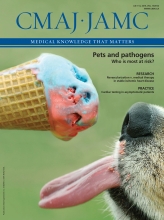Trends in dispensing long-acting non–tamper-resistant oxycodone near the Canada–US border
Since its introduction in 1996, long-acting oxycodone has been the target of regulatory efforts to curb misuse. An important step was the introduction of tamper-resistant long-acting oxycodone and removal of the original formulation from the US market in August 2010. The original formulation remained on the Canadian market until late 2011, however, and researchers noted excess tablets dispensed by Canadian retail pharmacies near the Canada–US border during this time. In November 2012, Health Canada authorized the marketing of generic non–tamper-resistant versions, which reopened the potential for inappropriate prescribing and dispensing behaviour. In this study, researchers conducted a retrospective analysis of trends in dispensing long-acting oxycodone from Canadian retail pharmacies in 50 border regions between Feb. 1, 2012, and Jan. 31, 2014. They found no large increases in the dispensing rates of generic non–tamper-resistant formulations in these regions after Health Canada’s authorization (Figure 1). The authors caution, however, that clinicians and pharmacists should remain vigilant in their prescribing and dispensing of oxycodone because of its high potential for misuse and abuse. See also www.cmaj.ca/lookup/doi/10.1503/cmaj.150274. CMAJ Open 2015;3:E231–5.
Rate of long-acting oxycodone tablet dispensing (per 1000 population) in regions near Canada–US border crossings, by province. Vertical dashed line indicates point at which generic formulations of the drug became available in Canada.
Mortality rates for unintentional carbon monoxide poisoning across Canada
Unintentional carbon monoxide poisoning, unrelated to fires, occurs mostly in indoor home environments through malfunctioning heating systems, improperly vented gas appliances and operation of gasoline-powered equipment in closed or semienclosed areas. In this study, researchers evaluated trends in mortality and hospital admission across Canada for unintentional nonfire-related carbon monoxide poisoning using data from the Vital Statistics Death Database. In Canada, there were 1808 deaths between 1981 and 2009, and 1984 admissions to hospital between 1995 and 2010 for this type of carbon monoxide poisoning. Deaths and admissions to hospital were most frequent among males and from September to April, with peaks in December and January (Figure 2). These rates decreased over time, with average annual decreases of 3.46% (95% confidence interval [CI] −4.59% to −2.31%) and 5.83% (95% CI −7.79% to −3.83%) for mortality and hospital admission rates, respectively. Although these data are encouraging, the authors conclude that continued efforts are needed to reduce the occurrence of carbon monoxide poisoning, particularly in home environments. CMAJ Open 2015;3:E223–30.
Average mortality (1981–2009) and admission to hospital (1995–2010) for unintentional nonfire-related carbon monoxide poisoning in Canada.













